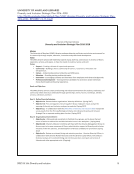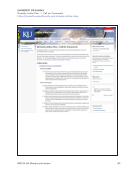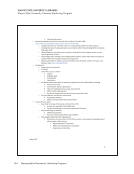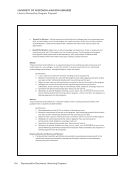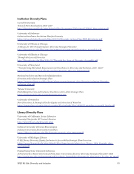4 Survey Results: Executive Summary
Funding Strategies
Responses to a question about whether the library has dedicated funding to support diversity/inclusion
efforts were split fairly evenly between libraries who reported they do (35 or 52%) and those who do
not (32 or 48%). Thirty-four of the respondents who have dedicated funding said the source is the
general library budget. Twelve of these also receive support from the parent institution. Eight libraries
supplement their primary funding with federal, state, and/or private grants. One receives funding solely
from the parent institution. Several respondents commented that the dean has a discretionary fund
from which resources can be requested. The majority of respondents reported that funding supports
professional development, workshops, program development, leadership development, recruitment
efforts, and travel. Comments about other activities reflect support for residency programs that increase
the number of diverse staff. At 16 libraries the level of funding has increased over the last five years at 17
it has stayed about the same. Only two respondents said that funding has decreased.
Programs to Promote an Inclusive Workplace
The majority of respondents use a variety of staff development strategies to promote an inclusive
workplace. These include presentations, workshops, programs, and exhibits, as well as specialized efforts
that focus on adding diverse general, special, and online resources to library collections. Examples of
these efforts include training on conflict management, implicit bias, microaggressions, cultural and
gender identity, and safe zones book talks and poster sessions exhibits for K–8 students and travel
support for diversity conferences.
These efforts are planned and delivered by a wide variety of individuals and groups, most
often by a library diversity committee or similar group and/or a personnel officer. Forty-four libraries
responded that other individuals and/or groups are also involved with planning or delivering diversity
programs, including departments, units, other committees and working groups, branch libraries, subject
specialists, and museum staff. Widespread programming is taking place at the staff, librarian, and library
administration levels. Collaborations with campus partners and community activists also strengthen
the types of programs offered. Almost all of the responding libraries are taking advantage of training
opportunities provided by the parent institution and many send staff to training provided by professional
organizations such as ALA, ACRL, and ARL.
When asked about use of the 2012 ACRL Diversity Standards, 50 respondents (77%) reported
they have not used them in any way. Those who had, mostly used them as a reference in the creation of
their own institution’s diversity plan.
Recruitment Strategies
All but seven of the 68 responding libraries have or plan to develop recruitment strategies to increase
ethnically/culturally diverse applicant pools. Many of the strategies are not new, but the most successful
ones include training search committee members on how to develop a diverse candidate pool, targeting
job ads to participants of diversity enhancement recruitment programs such as ARL’s Initiative to Recruit
a Diverse Workforce (IRDW) and ALA’s Spectrum Scholars program, offering a post-LIS residency
program, and supporting ARL initiatives that attract librarians from racially and ethnically diverse groups
to the profession.
There is about an equal split between libraries that feel their strategies have led to pools that are
more inclusive (53% )and those that do not (47%). Comments revealed there is little data to support these
feelings because the information either isn’t tracked or lies in the hands of the parent institute and is not
shared with library search committees. One respondent noted that the diversity of their pools increased
after implementing an initiative that gives applicants extra credit for military service, since “veterans tend
to be a diverse group.”
Funding Strategies
Responses to a question about whether the library has dedicated funding to support diversity/inclusion
efforts were split fairly evenly between libraries who reported they do (35 or 52%) and those who do
not (32 or 48%). Thirty-four of the respondents who have dedicated funding said the source is the
general library budget. Twelve of these also receive support from the parent institution. Eight libraries
supplement their primary funding with federal, state, and/or private grants. One receives funding solely
from the parent institution. Several respondents commented that the dean has a discretionary fund
from which resources can be requested. The majority of respondents reported that funding supports
professional development, workshops, program development, leadership development, recruitment
efforts, and travel. Comments about other activities reflect support for residency programs that increase
the number of diverse staff. At 16 libraries the level of funding has increased over the last five years at 17
it has stayed about the same. Only two respondents said that funding has decreased.
Programs to Promote an Inclusive Workplace
The majority of respondents use a variety of staff development strategies to promote an inclusive
workplace. These include presentations, workshops, programs, and exhibits, as well as specialized efforts
that focus on adding diverse general, special, and online resources to library collections. Examples of
these efforts include training on conflict management, implicit bias, microaggressions, cultural and
gender identity, and safe zones book talks and poster sessions exhibits for K–8 students and travel
support for diversity conferences.
These efforts are planned and delivered by a wide variety of individuals and groups, most
often by a library diversity committee or similar group and/or a personnel officer. Forty-four libraries
responded that other individuals and/or groups are also involved with planning or delivering diversity
programs, including departments, units, other committees and working groups, branch libraries, subject
specialists, and museum staff. Widespread programming is taking place at the staff, librarian, and library
administration levels. Collaborations with campus partners and community activists also strengthen
the types of programs offered. Almost all of the responding libraries are taking advantage of training
opportunities provided by the parent institution and many send staff to training provided by professional
organizations such as ALA, ACRL, and ARL.
When asked about use of the 2012 ACRL Diversity Standards, 50 respondents (77%) reported
they have not used them in any way. Those who had, mostly used them as a reference in the creation of
their own institution’s diversity plan.
Recruitment Strategies
All but seven of the 68 responding libraries have or plan to develop recruitment strategies to increase
ethnically/culturally diverse applicant pools. Many of the strategies are not new, but the most successful
ones include training search committee members on how to develop a diverse candidate pool, targeting
job ads to participants of diversity enhancement recruitment programs such as ARL’s Initiative to Recruit
a Diverse Workforce (IRDW) and ALA’s Spectrum Scholars program, offering a post-LIS residency
program, and supporting ARL initiatives that attract librarians from racially and ethnically diverse groups
to the profession.
There is about an equal split between libraries that feel their strategies have led to pools that are
more inclusive (53% )and those that do not (47%). Comments revealed there is little data to support these
feelings because the information either isn’t tracked or lies in the hands of the parent institute and is not
shared with library search committees. One respondent noted that the diversity of their pools increased
after implementing an initiative that gives applicants extra credit for military service, since “veterans tend
to be a diverse group.”


















































































